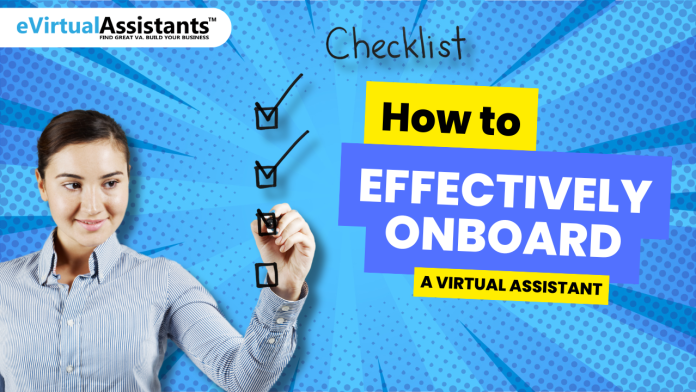You’ve made a strategic business decision: hiring a virtual assistant. This is a pivotal step towards unlocking increased productivity, scaling your operations, and ultimately, achieving business growth. However, the journey to a seamless collaboration begins with a robust onboarding process. While many entrepreneurs view onboarding as a mere formality, it’s actually the cornerstone of a successful virtual assistant-client relationship.
Key Takeaways:
- Effective onboarding is essential for maximizing the value of your virtual assistant.
- A well-structured onboarding process sets the stage for a productive and long-lasting partnership.
- By investing time in onboarding, you can boost efficiency, reduce turnover, and enhance overall business performance.
This comprehensive guide will equip you with the knowledge and strategies to master the art of onboarding, transforming your virtual assistant into a valuable asset for your business.
Understanding the Importance of Onboarding a Virtual Assistant

A well-structured onboarding process for your virtual assistant is paramount for several reasons:
- Enhanced Productivity: A smoothly onboarded VA can quickly ramp up, contributing significantly to your business efficiency.
- Stronger Client Relationships: A satisfied virtual assistant is more likely to deliver exceptional service, positively impacting client satisfaction.
- Reduced Turnover: A positive onboarding experience fosters loyalty and reduces the risk of virtual assistant turnover.
- Improved Business Performance: By delegating effectively, you can focus on strategic initiatives, driving business growth.
Defining Roles and Expectations: The Foundation of a Successful Partnership
Before diving into the onboarding process, it’s essential to clearly define the virtual assistant’s role and responsibilities. This involves:
- Conducting a Thorough Task Analysis: Identify tasks that are time-consuming or hindering your productivity. These are prime candidates for delegation.
- Crafting a Detailed Job Description: Create a comprehensive job description outlining specific duties, expectations, and performance metrics.
- Setting SMART Goals: Establish clear, specific, measurable, achievable, and time-bound goals for your virtual assistant.
Building a Strong Foundation: Essential Onboarding Steps
A successful onboarding process involves a structured approach:
Step 1: Warm Welcome and Company Orientation

- Extend a Personalized Welcome: Make your virtual assistant feel valued from the start.
- Provide a Company Overview: Share your business’s mission, vision, and values.
- Introduce the Team: Facilitate introductions to key team members.
Step 2: Role Definition and Expectations
- Reiterate Job Responsibilities: Clearly communicate the virtual assistant’s role and duties.
- Set Performance Expectations: Outline performance metrics and goals.
- Discuss Communication Protocols: Establish preferred communication channels and response times.
Step 3: Comprehensive Training
- Task-Specific Training: Provide detailed instructions and demonstrations for assigned tasks.
- Tool and Software Training: Ensure proficiency in necessary tools and platforms.
- Process Documentation: Create clear and accessible process documentation.
Step 4: Workspace Setup
- Provide Necessary Equipment: Equip your virtual assistant with essential tools.
- Grant System Access: Provide access to relevant systems and platforms.
- Establish a Secure Workspace: Ensure a secure working environment for sensitive information.
Step 5: Fostering Collaboration and Trust
- Schedule Regular Check-ins: Maintain open communication through regular meetings.
- Encourage Feedback: Create a culture of open and honest feedback.
- Build Rapport: Foster a positive and collaborative working relationship.
Recommended Read: How to Efficiently Manage a Remote Team of VAs from the Philippines
Overcoming Common Onboarding Challenges
Onboarding isn’t always smooth sailing. Be prepared to address potential challenges:
- Overwhelming Information: Break down training into manageable modules.
- Communication Gaps: Utilize clear and concise communication channels.
- Technical Difficulties: Provide prompt technical support.
- Cultural Differences: Respect cultural nuances and build cross-cultural understanding.

Measuring Onboarding Success
To assess the effectiveness of your onboarding process, track key metrics:
- Time to Productivity: Measure the time it takes for the virtual assistant to become fully operational.
- Task Completion Rate: Evaluate the efficiency of task execution.
- Error Rate: Monitor the accuracy of work performed.
- Virtual Assistant Satisfaction: Assess the virtual assistant’s overall job satisfaction.
Onboarding Virtual Assistants with evirtualassistants
Finding the right virtual assistant can be challenging. That’s where evirtualassistants comes in. We simplify the process by connecting you with a vast pool of skilled and experienced virtual assistants.
Getting Started with evirtualassistants
Ready to streamline your operations and boost productivity? Partner with evirtualassistants. With over 200,000 skilled virtual assistants and a proven track record of helping over 5000 businesses, we’re your trusted partner in finding the perfect virtual assistant.



